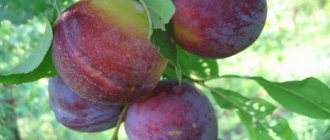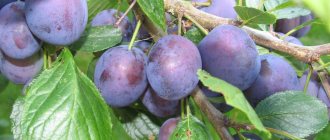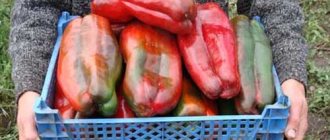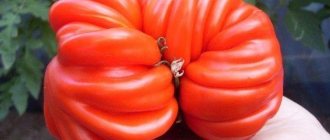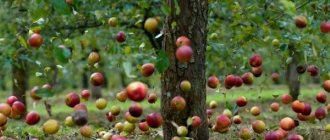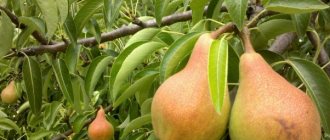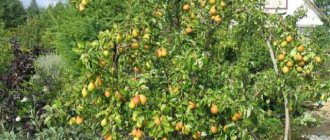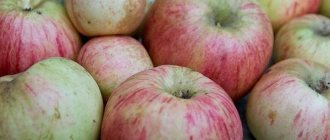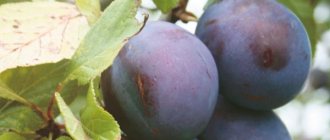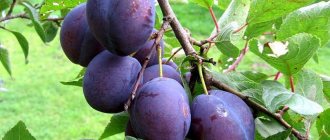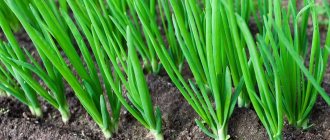The Manchurian beauty plum does not have any special requirements for growing conditions; it is characterized by high frost resistance and the ability to form stable, albeit moderate, yields.
To grow this compact tree on your site, it is enough to follow the correct agricultural techniques and give preference to good quality planting material.
Historical reference
Manchurian beauty is an old variety of domestic Chinese plum, known since the late 20s of the 20th century. It was obtained at the Yaomen experimental station in Manchuria.
The seedlings were selected and sent from Manchuria by the scientist M.F. Ivanov . So the plant ended up in the Far East with breeders N.N. Tikhonov and A.A. Taratukhin, who adapted and distributed the promising variety.
The Manchurian beauty was bred by crossing 3 types of plums: Ussuri, Chinese, Simona.
Characteristics of the variety
The largest-fruited among the Ussuri plums, the Manchurian beauty, has its own characteristics.
Drought resistance, frost resistance
An ancient variety, bred on the basis of the most cold-resistant type of plum - Ussuriyskaya, tolerates frosts down to -35...-40 °C. It is not for nothing that many varieties of plums for the Far Eastern and Siberian regions have been created on its basis. The tree can withstand dry periods, but with watering the harvest is better.
Pollinators of plum Manchurian beauty
Many types of Ussuri plums do not bear fruit without pollinators. Over the years of cultivation, the best trees for pollination of the Manchurian tree have been determined:
- Ural golden;
- Ural red;
- Ussuriyskaya;
- Manchurian prunes.
It is advisable to have 2-3 different species in the garden for better cross-pollination and a bountiful harvest.
Manchurian plum blooms early, when there are no leaves on the tree. The date depends on the growing region, but plums are often purchased as a highly decorative spring garden element. The fruits of the Manchurian beauty ripen in late summer - early autumn.
Productivity and fruiting
The variety is early fruiting. Plums are tried three years after planting a one-year-old tree. Productivity is stable in the presence of pollinators. A young plum produces 8–10 kg, an adult plum produces up to 20–24 kg.
Warning! Old variety plums are harvested 3-4 days before they are completely ripe, otherwise they will quickly fall off.
Area of application of berries
The fruits of the Manchurian plum are delicious for consumption as a dessert, as well as in preparations. Compotes, preserves, and jams are made from the berries. The fruits are frozen, so almost all valuable substances are preserved.
Resistance to diseases and pests
Plum is little susceptible to characteristic lesions of the species:
- The Manchurian plum is resistant to a common disease in the Far East - rubella;
- does not succumb to the scourge of plum trees - clasterosporia;
- The beauty is little susceptible to infection with fungi that cause coccomycosis.
But the Manchurian plum is affected by moniliosis. It is necessary to carry out prevention against diseases and pests and adhere to the basic requirements of agricultural technology for garden care in autumn and spring.
Regions of growth
The early-ripening plum variety Manchurian Beauty is zoned in several regions of Russia , namely:
Ural;- Far Eastern;
- East Siberian;
- West Siberian.
The variety is also recommended for cultivation in the European part of the country, throughout Siberia and the Far East.
Peculiarities
The plum blossom period is wonderful. The description of the “Manchurian beauty” at this time cannot be expressed in words.
Each inflorescence contains three buds. The flowers bloom before the leaves, creating a stunning, incomparable view.
The disadvantage can be considered early flowering - already in early May. In temperate climates, spring frosts often occur at this time. In this case, the flowers fall off.
The variety belongs to the self-sterile species. So when planting such varieties, you need to carefully consider the presence of the necessary pollinator neighbors.
Fruiting occurs in the third year after planting. The yield of plums is stable.
Botanical description of the variety and photo
The Manchurian beauty is easy to distinguish from other famous varieties of plums based on individual characteristics and characteristics.
Characteristics of wood
A fruit tree up to 1.8 m in height has:
- rounded, dense crown;
- gray bark with a brown tint;
- weakly defined bole;
- curved shoots of brown color;
- numerous, light lentils;
- small leaves, up to 11 cm long, up to 4 cm wide, elliptical in shape, dark green in color with a pointed tip.
At the time of flowering, the plant is highly decorative, since the massively opening buds are collected in miniature inflorescences of white or pink color.
The ripening plums also sit spectacularly thick on the branches.
In the photo there is a Manchurian beauty:
Consumer properties and composition of fruits
The Manchurian Beauty plum variety has captivated gardeners and consumers with its tasty and aromatic fruits, which have :
- rounded shape, flat base, with a deep narrow funnel;
- dark burgundy skin with a blue coating of moderate density;
- yellow-green, juicy, dense pulp with a loose structure;
- balanced taste, harmoniously combining sweetness and acidity;
- an oval-pointed stone, easily separated from the pulp;
- average value 20-30 g.
Chemical studies have shown that the pulp contains about 17-24% dry matter, as well as:
| Substance name | Quantity per 100 g of product |
| Ascorbic acid | 7-9mg |
| Sahara | 8-15% |
| Titratable acids | 0,9-1,7% |
| Tannins | 0,37-0,41% |
| P-active substances | 325-350 mg |
A universal variety, good both fresh and for winter preparation, as well as for the production of prunes.
Description of the Manchurian Beauty plum
This variety can be recognized among other plum crops by the following characteristic features:
- Tree. It is a dwarf plant (many even consider it a bush). The trunk of this plum is very slightly expressed.
- Crown, branches. When growing up, this natural dwarf develops a tip that is mainly round (usually oval) in shape.
The bark on the skeletal branches is colored either brown or gray-brown. - The texture of the bark is predominantly flaky. Even in the nursery, active branching is observed in the seedlings due to the high awakening of the buds.
- Escape. They generally have a slightly curved appearance.
On relatively thin shoots, colored in red-brown shades, many light-colored lentils can be distinguished.The vegetative buds formed on the shoots are small in size, while the fruit buds are generally large in appearance.
Leaves. The length of a standard leaf of this variety is approximately 10 cm and the width is 4 cm.
The leaves form an ellipse. The color is dark green, the leaf surface has a slight gloss.The leaf blade is somewhat concave, the apex is pointed. The leaves are held on dark petioles.
- Inflorescences. Formed from 3 small flowers. The color of the flowers is white.
- Fruit. Usually the plum weight reaches 15 g. The base of the round fruit is flattened, the funnel is narrow and deep.
There is a faint seam. The base color of the fruit is yellow-orange, with a touch of burgundy and blue blush. - The color of the pulp is yellow-green, the pulp is characterized by a fairly high density and increased juiciness. The medium-sized bone has the silhouette of a pointed oval and is easily separated from the pulp. Plums are firmly held on shortened stalks.
Pollination
When growing the Manchurian Beauty plum, you need to take into account that the variety is self-sterile, and for a good harvest it needs pollinating trees nearby.
Therefore, to form the ovary and increase the yield,
of plums nearby
- Ussuriyskaya.
- Ural red.
- Ural golden.
- Prune Manchurian.
The productivity of plums increases significantly if you plant 2-3 varieties of crops with similar flowering periods near it.
How to plant a tree on a plot
When planning to plant a tree of this variety, it is necessary to correctly determine the site and prepare fertile soil.
Required soil composition
Manchurian beauty is demanding on soil quality. Fertile, permeable soil is recommended for her. Loamy black soil is best.
Selection and preparation of a site
A plum tree will be most productive if it is planted in an area with good sunlight. It is important that the chosen location is protected from strong winds and drafts.
Holes for planting plums should be dug on a slightly elevated surface. If you plant a plum in a low area, it will suffer from stagnant cold air.
The minimum depth of groundwater in the planting site is one and a half meters.
Dimensions and depth of the landing pit
The optimal width of planting holes for plum trees is 80 centimeters, and the depth is 60-70.
Terms and rules for planting the Manchurian Beauty plum
The Manchurian Beauty plum is planted in open ground in spring or autumn. In harsh cold climates, the optimal time for planting is spring. When planting in autumn, the seedling is likely to freeze and will not have time to take root in a short time. In other regions, the planting period depends on the wishes of the gardener and weather conditions.
Harvest and storage
Harvesting occurs in the last days of August or the first ten days of September. Due to uneven ripening, fruits from the tree must be removed in 2-3 approaches, maximum on the second day after ripening , as they are prone to shedding. It is better to do this in the morning on a dry and clear day.
The shelf life of the crop is 7-10 days. To prevent the fruits from quickly deteriorating during this time, during storage it is important to maintain a temperature of 0-2°C and a humidity level of at least 85%. It is better to put fruits in wooden boxes or low trays covered with paper.
For longer storage, it is recommended to freeze or dry plums.
Landing rules
It is recommended to plant in the spring. This is necessary so that the young tree has time to take root well and grow stronger. In this case, it will withstand winter frosts well.
It is advisable to plant seedlings at the end of April, before the buds open.
You need to choose a place that is well lit. It is undesirable to plant seedlings along walls and in places with large accumulations of snowdrifts. The ideal location is on the south and southwest side.
Read also: Diseases of fruit trees and their treatment with photos and videos
If the site has hills or small slopes, then this place is ideal for planting plum crops.
Plum loves light, fertile soil. Does not tolerate acidic soil. When planting, it is worth considering the remoteness of groundwater (no closer than 1.5-2 meters to the roots of the tree).
A hole is dug with a diameter of about 70 cm and a depth of 50 cm. When planting, the roots are carefully straightened. To fill the hole, you need to add peat with the addition of ash or humus mixed with a small part of river sand.
The root collar mainly rises above the ground by about 5 cm.
After planting, the seedling is watered abundantly with water, up to 4 buckets.
How to plant correctly?
Like every fruit tree, the Manchurian Beauty plum variety has its own timing and requirements for planting, which must be taken into account, since a small error can lead to the death of the plant.
Recommended timing
It is better
to plan planting work in harsh climatic conditions in (April, May), since seedlings planted in autumn do not always have time to take root and freeze in winter.
In other areas, the time for planting should be chosen based on weather conditions and soil temperature.
Site requirement
When choosing a site for planting, you should consider the following factors :
- sunny area, protected from gusty winds;
- southern or southwestern side of the site;
- groundwater lying at a depth of no higher than 1.2 m;
- fertile loamy and soddy-podzolic soil with neutral acidity.
Since the Manchurian beauty plum tends to dry out, you need to choose a place in the garden where the least amount of snow accumulates. Trees should not be planted in close proximity to a wall, fence, or fence.
Selection and preparation of seedlings
Manchurian beauty plum seedlings must have a number of characteristics that confirm their quality:
- healthy, well-developed root system, without dry roots;
- fresh and elastic branches and trunk without mechanical damage to the bark, growths, swellings;
- no signs of disease, broken branches, dry leaves.
The optimal age for a tree is 1-2 years; such planting material quickly takes root in a new place.
Before planting, the roots of the seedlings should be placed in a clay mash for 1 hour.
Work technology
Stages of planting seedlings:
- Dig a hole; its optimal width should be 80 cm and depth 60-70 cm.
- At the bottom of the hole, form a hill from a soil mixture containing garden soil, 15 kg of rotted compost, 150 g of superphosphate and 30 g of potassium sulphide.
- Drive a wooden peg into the center of the hole to securely support the tree.
- Carefully place the seedling in the hole, carefully straightening the roots on the earthen hill, while the root collar should be 7 cm above the ground level.
- Carefully fill the hole halfway, not forgetting to compact the soil.
- Water using 1 bucket of water per plant.
- Fill the hole completely.
- Tie the young tree to a stake.
- Water the plum again using 30 liters of water.
- Mulch the tree trunk circle with sawdust.
When planting several seedlings, it is important to maintain a distance between trees of 1.5-2 m, and between rows - 2-3 m.
Growing rules
It is best to plant plums in the spring, when the weather is warm. These conditions will help young seedlings take root. When the tree grows, it is necessary to pay special attention to it in the spring - this is the time when spoil appears on the trunk.
The plum ripens early - by the end of August the fruits ripen and begin to fall to the ground. Due to the medium-thick skin, plums do not break on the ground and retain their appearance.
It is especially worth paying attention to the soil and place where the Manchurian beauty is planned to be planted. The soil should be loose, homogeneous and not acidic. The tree should not be planted too close to groundwater on the sunny side of the yard. The plum tree takes root especially well on small mounds, which allows it to capture more sunlight; there will be no accumulation of snow or moisture on the trunk, which causes the root to rot.
You can prune a young tree strictly until it is 3 years old. At a later age, this can lead to death due to gum production. It is not recommended to grow this type of plum alone, because it will not bear fruit. A few more plums should be planted at a distance of up to 3 m. During flowering, the plant cannot be sprayed with anything; it is also better not to water it.
Growing from seed
You can grow a plum by planting a seedling, cuttings, layering, or even a fruit seed. Unlike planting seedlings, stones need to be planted in the fall. Before doing this, it is necessary to carry out simple activities.
- Rinse the seed well and dry in a warm place or in the sun.
- Remove the seed from the shell and add warm water.
- The seeds remaining at the bottom are suitable for sowing.
- Dry the seed, place it in a container with substrate, close tightly and shake.
- Place in the refrigerator for 4-6 months, moistening the soil as necessary during this time.
- Plant in a flower pot with well-moistened soil. Place a layer of expanded clay or charcoal on the bottom of the flowerpot. It is worth immediately accustoming the plant to the soil in which it will grow. To do this, in a 2-3 liter pot you need to put 2 parts of fertilized soil from the garden, part peat and sand.
- Cover the pot with polyethylene and place it on the windowsill on the sunny side of the house.
These measures will help the Manchurian plum germinate faster. After the sprouts appear, they should be cared for in the same way as other house plants. It is not recommended to leave the pot in a draft.
Planting in the soil
The plum should be planted away from other trees, but at a distance of at least 3 m from other types of plums. For the process to be successful, the following sequence must be followed:
- a couple of days before planting, mix the soil from the future hole with humus in a ratio of 1:10, then put it back, leaving room for the seedling;
- the hole for planting the seed should be made deep, 0.6x0.6 m;
- before transplanting, water the soil in the pot and pour it into the hole;
- put hay on top, water-repellent fabric and wrap the crown with burlap.
You can do without planting in a pot and immediately plant plum seeds in the garden in winter, and from April begin to care for it as expected.
To plant a plum seedling, you need to dig a hole 50 cm deep and 70 cm in diameter 2 weeks before planting. After 2 weeks, you can start planting. The seedling must be straightened and covered with soil so that the root collar rises at least 4 cm above the ground.
Papier-mâché crafts: manufacturing technique for beginners, video instructions and step-by-step manufacturing master class (90 photos)
Usually they are covered with soil from a hole mixed with humus, sand, potassium chloride, saltpeter, etc. After this, you need to water the plant generously with settled water.
Care instructions
Caring for a fruit tree is not difficult; it is important to provide it with proper watering, fertilizing, and systematically prune the crown and treat the tree trunk area.
Watering and fertilizing schedule
Although the Manchurian Beauty variety boasts high resistance to drought, it still needs additional watering. Trees should be moistened once a month, trying to wet the soil to a depth of 40 cm.
Fertilizers must be applied strictly according to the fertilizing schedule.:
- In the spring, before the buds appear, scatter 25 ammonium nitrate and 40 g of potassium salt per 1 m2 of tree trunk.
- At the flowering stage, feed with a solution of 20 g of urea diluted in 10 liters of water. Consumption - 5 l / tree.
- After flowering, saturate with a liquid solution of mullein diluted in water (1:3) with the addition of 50 g of superphosphate per 10 liters.
- In early June, irrigate the crowns with a solution (1%) of urea.
- At the beginning of autumn, adding a nutritional composition of 3 tbsp. l. superphosphate and 2 tbsp. l. potassium sulphide per bucket of water. Consumption - 20 l / tree.
You need to start feeding the tree 1 year after planting.
Trimming
Pruning should be done in spring or autumn before frost. Form the crown of the tree from the 2nd year and continue until 4 years .
Subsequently, remove ineffective branches, damaged, dry shoots. After the procedure, the sections should be treated with special means (garden pitch, rosin, oil or acrylic paint).
Wintering
also important to prepare the Manchurian beauty plum for the winter:
- Cover young seedlings using special gardening material.
- Whiten the trunks and bases of skeletal branches of mature trees.
- Mulch the tree trunk areas with sawdust in a layer of 7-8 cm.
To protect tree trunks from hares, it is recommended to tie them with garden netting. And in the fight against rodents, set traps.
Plant care
In the first year, Manchurian plum does not require special feeding products. It is necessary to water periodically and monitor the looseness of the soil. During flowering, the plant needs special attention and abundant watering. Insufficiently moistened soil can cause the ovaries to fall off, which will lead to a reduction in the number of fruits and a decrease in their size.
In the first winter, the seedling should be protected from the cold with paper or non-woven material. You can burn the fallen leaves and dig up the ground near the trunk. This will help the tree not to freeze and prevent the appearance of rot or rot.
To increase the yield, cover with straw and manure. After a few years, nitrogen fertilizers are applied in the spring to make it easier for the tree to produce new shoots and ensure their vital activity.
Diseases and pests
The Manchurian beauty plum demonstrates resistance to coccomycosis, rubella, and clasterosporiosis. But with poor care, it can be susceptible to diseases such as :
- red spot;
- gray rot;
- gum therapy.
When the first signs of infection appear, it is necessary to prune the affected parts, pick off rotten plums, remove and burn all plant debris near the tree.
Among the pests, the plant can be favored by the plum moth and sawfly. Insecticides will help get rid of insidious insects.
For prevention purposes it is necessary:
- Periodically thin out the crown.
- Clean the tree trunk circle from falling fruits and leaves.
- Burn fallen leaves and cut branches.
- In the fall, after fruiting has finished, dig up the soil.
- Treat plants with Bordeaux mixture three times a season.
You also need to regularly inspect the garden and, if a problem is detected, determine the type of disease and promptly spray with protective agents.
Agricultural technology
Experts recommend planting the Chuya beauty plum in the spring, when the weather outside has already become quite warm. In such conditions, seedlings are more likely to take root and take root. While the young tree is growing, it requires especially close attention. It is at the initial stage of plum cultivation that the risk of prell appearing on the trunk is especially high.
Adenium - what to do if leaves and soft caudex fall off?
Particular attention should be paid to the planting site and soil. The soil should be non-acidic, loose and always homogeneous. Under no circumstances should the crop be planted in areas with close groundwater.
Planting plum
The best described type of plum takes root on relatively small slopes, where there is enough sunlight, and moisture and snow will not accumulate on the plant trunk (it is these that in most cases cause rotting of the root system).
You should not spray plants with any useful compounds during the flowering period. At this time, the plum should not even be watered.
You can grow plums in different ways:
- seedlings;
- cuttings;
- layering;
- fruit seeds.
Unlike seedlings, the seed must be planted in the ground in the fall. Before doing this, some simple preparatory measures are required. In particular, the seed must be thoroughly washed and dried well in the sun or on a radiator. Then the seed must be removed from the shell and filled with warm water. The seed is then dried and placed in a container with substrate. A tightly closed container should be stored in the refrigerator for 4 to 6 months, periodically moistening the soil. Then the prepared planting material is planted in a flower pot with moistened soil. A layer of charcoal or expanded clay should be placed at the bottom of the pot.
After planting is completed, the container will remain covered with polyethylene and placed on the windowsill until the sprouts appear. You should care for your sprouts in the same way as you would any other indoor plants.
Plum grown from seed
Planting the Manchurian beauty in the soil should be done away from other trees and no less than three meters from other varieties of plums. For the procedure to be successful, a few days before planting, the soil from the future pit is mixed with humus in a ratio of 1:10 and put back. In this case, it is necessary to leave room for the seedling. The hole will need to be quite large - approximately 0.6 x 0.6 m. When placed in the hole, the seedling must be carefully straightened and covered with earth so that the root collar is at least 4 centimeters above the soil surface. After planting, the plant requires abundant watering with settled water.
Little is known, but insufficiently moist soil can cause the ovaries to fall off and reduce the yield.
In the first winter, the seedling needs mandatory insulation. You can protect the crop from frost using non-woven material or paper. Alternatively, you can burn the fallen leaves and dig up the soil near the trunk. The described manipulations will not only help the plant not to freeze, but will also reduce the risk of rot developing.
To cover a plum tree for the winter, you can burn fallen leaves and dig up the ground near the trunk
An adult plant, cultivated for several years, is fed with nitrogen fertilizers in the spring. They are necessary to accelerate the growth of new shoots and ensure the life of the tree as a whole.
The Manchurian beauty has strong immunity to most diseases and pests. But the crop may well develop a monolithic burn, which can lead to drying out of the affected parts of the tree and rotting of the fruit. In the fight against this problem, a four percent solution of Bordeaux mixture will be an effective remedy.
Pest protection
Advantages and disadvantages
The Manchurian beauty plum has a number of advantages, thanks to which it has been popular among gardeners for many years, even despite the abundance of new varieties:
stable yield;- good taste and consumer properties;
- universal use of crops;
- high frost resistance;
- resistance to diseases and harmful insects;
- resistance to adverse environmental conditions;
- ease of care.
Among the disadvantages it is important to note:
- the need for constant crown molding due to the active growth rate of the plant;
- dependence of the variety’s yield on other pollinators;
- tendency to shed fruits from branches.
Against the background of the large number of advantages of the variety, its disadvantages are almost invisible.
Reviews from gardeners
Experienced gardeners recommend the Manchurian beauty plum for both small household plots and commercial plantings.
Due to its high frost resistance and immunity to diseases and pests, most summer residents and agronomists classify the fruit as a promising and valuable variety . And if you take into account its excellent taste and commercial properties, the choice becomes obvious.
You can find out the opinions of gardeners about the Manchurian beauty plum here and here.
Plum diseases and pruning
The Manchurian beauty plum variety is quite resistant to various diseases. And it doesn’t cause much interest to pests.
But the plum tree is susceptible to root collar rot. A disease such as moniliosis can also harm the tree. It is characterized by drying of the branches, and the fruits begin to rot.
It is better to prevent the disease than to treat the tree for a long time. For prevention, it is enough to periodically thin out the tree. And, of course, you need to regularly remove dry leaves and fallen fruits from the root circle.
If the disease begins to develop, you should not delay treatment. The more time is lost, the more difficult it will be to correct the situation. Spraying with Bordeaux mixture, which should be carried out 3 times in dry weather, will help eliminate the problem.
The first 2-3 years are relatively important for the formation of a correct and strong skeleton. Excess branches that spoil the crown are removed. Root shoots are removed in a timely manner.
Pruning is usually carried out in early spring or late autumn, just before frost.
Light pruning can be done during the period of full fruiting of the Manchurian beauty plum. A photo of pruning unnecessary branches shows how to increase the growth of young shoots.
In the second year of the tree’s life, a tiered crown is formed. After three years of age, old and improperly growing branches are simply removed. The cut areas must be treated with garden varnish.
Of course, this type of plum deserves to be present on every site. This fruit beauty will delight its owners with its tasty and abundant harvest for many years.
